TFA 30.1048 Bruksanvisning
TFA
Termometer
30.1048
Läs gratis den bruksanvisning för TFA 30.1048 (4 sidor) i kategorin Termometer. Guiden har ansetts hjälpsam av 13 personer och har ett genomsnittsbetyg på 4.3 stjärnor baserat på 7 recensioner. Har du en fråga om TFA 30.1048 eller vill du ställa frågor till andra användare av produkten? Ställ en fråga
Sida 1/4

Digitales Einstichthermometer
Vielen Dank, dass Sie sich für dieses Produkt aus dem Hause TFA entschieden haben.
1. Bevor Sie mit dem Gerät arbeiten
• Lesen Sie sich bitte die Bedienungsanleitung genau durch.
• Durch die Beachtung der Bedienungsanleitung vermeiden Sie auch Beschädigungen des
Gerätes und die Gefährdung Ihrer gesetzlichen Mängelrechte durch Fehlgebrauch.
• Für Schäden, die aus Nichtbeachtung dieser Bedienungsanleitung verursacht werden, über-
nehmen wir keine Haftung. Ebenso haften wir nicht für inkorrekte Messwerte und Folgen, die
sich aus solchen ergeben können.
• Beachten Sie besonders die Sicherheitshinweise!
• Bewahren Sie diese Anleitung gut auf!
2. Einsatzbereich und alle Vorteile Ihres neuen Gerätes auf einen Blick
• Temperaturmessung von flüssigen, pastösen und halbfesten Objekten für Haushalt, Beruf und
Hobby, auch für Lebensmittel gemäß HACCP
• Einstechfühler 140 mm
• Spritzwassergeschützt IP55
• Abschaltautomatik
3. Zu Ihrer Sicherheit
• Das Produkt ist ausschließlich für den oben beschriebenen Einsatzbereich geeignet. Verwenden
Sie das Produkt nicht anders, als in dieser Anleitung beschrieben wird.
• Das eigenmächtige Reparieren, Umbauen oder Verändern des Gerätes ist nicht gestattet.
• Dieses Gerät ist nicht für medizinische Zwecke bestimmt.
Vorsicht!
Verletzungsgefahr:
• Halten Sie das Gerät und die Batterie außerhalb der Reichweite von Kindern.
• Kleinteile können von Kindern (unter drei Jahren) verschluckt werden.
• Batterien enthalten gesundheitsschädliche Säuren und können bei Verschlucken lebensgefähr-
lich sein. Wurde eine Batterie verschluckt, kann dies innerhalb von 2 Stunden zu schweren inne-
ren Verätzungen und zum Tode führen. Wenn Sie vermuten, eine Batterie könnte verschluckt
oder anderweitig in den Körper gelangt sein, nehmen Sie sofort medizinische Hilfe in Anspruch.
• Batterien nicht ins Feuer werfen, kurzschließen, auseinandernehmen oder aufladen. Explosions-
gefahr!
• Um ein Auslaufen der Batterien zu vermeiden, sollten schwache Batterien möglichst schnell aus-
getauscht werden.
• Sollte eine Batterie ausgelaufen sein, vermeiden Sie Kontakt mit Haut, Augen und Schleimhäu-
ten. Spülen Sie ggf. umgehend die betroffenen Stellen mit Wasser und suchen Sie einen Arzt
auf.
Wichtige Hinweise zur Produktsicherheit!
• Setzen Sie das Gerät nicht extremen Temperaturen, Vibrationen und Erschütterungen aus.
• Nur der Fühler ist hitzebeständig bis 300°C.
• Halten Sie niemals den Fühler direkt über Feuer.
• Tauchen Sie das Anzeigeelement nicht in Wasser, sonst kann Feuchtigkeit eindringen und zu
Fehlfunktionen führen. Nicht in der Spülmaschine reinigen.
4. Inbetriebnahme
• Öffnen Sie das Batteriefach, indem Sie mit Hilfe einer Münze den Batteriefachdeckel in Pfeilrich-
tung drehen (OPEN) und entfernen Sie den Batterieunterbrechungsstreifen. Schließen Sie den
Deckel wieder.
• Entfernen Sie die Schutzfolie vom Display.
• Drücken Sie die ON/OFF Taste.
• Alle Segmente werden kurz angezeigt.
• Das Gerät ist jetzt betriebsbereit.
• Das Display zeigt Ihnen die aktuelle Temperatur an.
• Der Sensor befindet sich in der Sondenspitze. Stecken Sie den Fühler mindestens 2 cm tief in
das Messobjekt.
• Um das Gerät auszuschalten, drücken Sie die ON/OFF Taste.
• Bei Nichtbenutzung schaltet sich das Gerät nach 45 Minuten aus.
• Ziehen Sie die Schutzkappe über die Einstichsonde
5. Pflege und Wartung
• Reinigen Sie das Gerät mit einem weichen, leicht feuchten Tuch. Keine Scheuer- oder Lösungs-
mittel verwenden!
• Entfernen Sie die Batterie, wenn Sie das Gerät längere Zeit nicht verwenden.
• Bewahren Sie Ihr Gerät an einem trockenen Platz auf.
6. Befestigung
• Ziehen Sie eine Kordel durch die Befestigungsöse am Gerät und verknoten Sie sie.
7. Batteriewechsel
• Öffnen Sie das Batteriefach, indem Sie mit Hilfe einer Münze den Batteriefachdeckel in Pfeilrich-
tung drehen (OPEN) und legen Sie eine neue Batterie (LR44) ein (+Pol nach oben).
Digital Probe Thermometer
Thank you for choosing this instrument from TFA.
1. Before you use this product
• Please make sure you read the instruction manual carefully.
• Following and respecting the instructions in your manual will prevent damage to your instru-
ment and loss of your statutory rights arising from defects due to incorrect use.
• We shall not be liable for any damage occurring as a result of non-following of these instruc-
tions. Likewise, we take no responsibility for any incorrect readings or for any consequences
resulting from them.
• Please pay particular attention to the safety notices!
• Please keep this instruction manual safe for future reference.
2. Field of operation and all of the benefits of your new instrument at a glance
• Temperature measuring of liquids, pastes and semi-solid materials for household, business
and hobby, also for food checks (according to HACCP)
• Probe 140 mm
• Splash proof IP 55
• Automatic switch off
3. For your safety
• The product is exclusively intended for the field of application described above. It should only
be used as described within these instructions.
• Unauthorised repairs, modifications or changes to the product are prohibited.
• The product is not be used for medical purpose.
Caution!
Risk of injury:
• Keep this device and the battery out of reach of children.
• Small parts can be swallowed by children (under three years old).
• Batteries contain harmful acids and may be hazardous if swallowed. If a battery is swallowed,
this can lead to serious internal burns and death within two hours. If you suspect a battery
could have been swallowed or otherwise caught in the body, seek medical help immediately.
• Batteries must not be thrown into a fire, short-circuited, taken apart or recharged. Risk of
explosion!
• Low batteries should be changed as soon as possible to prevent damage caused by leaking.
• Avoid contact with skin, eyes and mucous membranes when handling leaking batteries. In case
of contact, immediately rinse the affected areas with water and consult a doctor.
Important information on product safety!
• Do not expose the device to extreme temperatures, vibrations or shocks.
• Only the probe is heat resistant until 300 °C.
• Never put the probe directly over fire.
• Do not immerse the display device into water. Water can penetrate and cause malfunction. Not
suitable for dishwasher.
4. Getting started
• Open the battery compartment by turning the lid in direction of the arrow by using a coin
(OPEN) and remove the insulation strip. Close the battery compartment again.
• Pull off the protection foil on the display.
• Press ON/OFF button.
• All LCD segments will light up for about a few seconds.
• The unit is ready for use.
• The actual temperature is shown on the display.
• The sensor is located in the point of the probe. To measure the temperature, insert the probe at
least 2 cm in the object.
• Press ON/OFF button to switch off the instrument.
• When the instrument is not used, it will automatically switch off after 45 minutes.
• Put the protective cap over the probe.
5. Care and maintenance
• Clean it with a soft damp cloth. Do not use solvents or scouring agents.
• Remove the battery, if you do not use the product for a long period of time.
• Keep the instrument in a dry place.
6. Attachment
• Pull a rope through the eyelet on the instrument and then knot them together.
7. Battery replacement
• Open the battery compartment by turning the lid in direction of the arrow by using a coin
(OPEN) and insert a new battery LR 44 (+ pole above).
• Pay attention to the sealing ring.
• Close the battery compartment by turning the lid counter-clockwise using a coin (CLOSE).
Digitales Einstichthermometer
• Achten Sie dabei auf den Dichtungsring.
• Schließen Sie das Batteriefach wieder, indem Sie mit Hilfe einer Münze den Batteriefachdeckel in
Pfeilrichtung drehen (CLOSE).
8. Fehlerbeseitigung
Problem Lösung
Keine Anzeige ➜ Batterie polrichtig einlegen (+ Pol nach oben)
➜ Batterie wechseln
➜ Gerät einschalten (ON)
Unkorrekte Anzeige ➜ Sitz des Messfühlers prüfen
➜ Batterie wechseln
Wenn Ihr Gerät trotz dieser Maßnahmen immer noch nicht funktioniert, wenden Sie sich an den
Händler, bei dem Sie das Produkt gekauft haben.
9. Entsorgung
Dieses Produkt und die Verpackung wurden unter Verwendung hochwertiger Materialien und
Bestandteile hergestellt, die recycelt und wiederverwendet werden können. Dies verringert den
Abfall und schont die Umwelt.
Entsorgen Sie die Verpackung umweltgerecht über die eingerichteten Sammelsysteme.
Entsorgung des Elektrogeräts
Entnehmen Sie nicht festverbaute Batterien und Akkus aus dem Gerät und entsorgen
Sie diese getrennt.
Dieses Gerät ist entsprechend der EU-Richtlinie über die Entsorgung von Elektro- und
Elektronik-Altgeräten (WEEE) gekennzeichnet.
Dieses Produkt darf nicht mit dem Hausmüll entsorgt werden. Der Nutzer ist ver-
pflichtet, das Altgerät zur umweltgerechten Entsorgung bei einer ausgewiesenen
Annahmestelle für die Entsorgung von Elektro- und Elektronikgeräten abzugeben. Die
Rückgabe ist unentgeltlich. Beachten Sie die aktuell geltenden Vorschriften!
Entsorgung der Batterien
Batterien und Akkus dürfen keinesfalls in den Hausmüll. Sie enthalten Schadstoffe wie
Schwermetalle, die bei unsachgemäßer Entsorgung der Umwelt und der Gesundheit
Schaden zufügen können und wertvolle Rohstoffe wie Eisen, Zink, Mangan oder Nik-
kel, die wiedergewonnen werden können.
Als Verbraucher sind Sie gesetzlich verpflichtet, gebrauchte Batterien und Akkus zur
umweltgerechten Entsorgung beim Handel oder entsprechenden Sammelstellen
gemäß nationalen oder lokalen Bestimmungen abzugeben. Die Rückgabe ist unent-
geltlich. Adressen geeigneter Sammelstellen können Sie von Ihrer Stadt- oder Kom-
munalverwaltung erhalten.
Die Bezeichnungen für enthaltene Schwermetalle sind:
Cd=Cadmium, Hg=Quecksilber, Pb=Blei.
Reduzieren Sie die Entstehung von Abfällen aus Batterien, indem Sie Batterien mit
längerer Lebensdauer oder geeignete wiederaufladbare Akkus nutzen. Vermeiden Sie
die Vermüllung der Umwelt und lassen Sie Batterien oder batteriehaltige Elektro- und
Elektronikgeräte nicht achtlos liegen. Die getrennte Sammlung und Verwertung von
Batterien und Akkus leisten einen wichtigen Beitrag zur Entlastung der Umwelt und
Vermeidung von Gefahren für die Gesundheit.
WARNUNG!
Umwelt- und Gesundheitsschäden durch falsche Entsorgung der Batterien!
10. Technische Daten
Messbereich Temperatur: -50 °C… 300 °C
Genauigkeit: ±1°C @ -10…+100 °C
±2°C @ -50..-10°C / >100…+200°C
±3°C @ >200°C
Arbeitsbereich: -5 °C…+50 °C
Schutzart: IP55
Spannungsversorgung: 1x LR44 Knopfzell-Batterie
Größe: 245 x 25 x 17 mm
Gewicht: 27,7 g (inkl. Batterie und Schutzhülle)
Bedienungsanleitung
Instruction manual
Mode d'emploi
Kat. Nr. 30.1048
TFA_No_30.1048_Anl_02_22 11.02.2022 15:52 Uhr Seite 1
Produktspecifikationer
| Varumärke: | TFA |
| Kategori: | Termometer |
| Modell: | 30.1048 |
| Vikt: | 24 g |
| Bredd: | 25 mm |
| Djup: | 17 mm |
| Höjd: | 235 mm |
| Material: | Plast |
| Modell: | Digital |
| Batterityp: | LR44 |
| Noggrannhet (max): | 3 ° C |
| Noggrannhet (min): | 2 ° C |
| Antal batterier: | 1 |
| Produktens färg: | Anthracite, White |
| bruksanvisning: | Ja |
| Skärmtyp: | LCD |
| Internationellt skydd (IP) kod: | IP55 |
| Batterier medföljer: | Ja |
| Temperatur mätenheter: | °C |
| Temperaturområde (T-T): | -50 - 300 ° C |
| Stem storlek: | 140 mm |
Behöver du hjälp?
Om du behöver hjälp med TFA 30.1048 ställ en fråga nedan och andra användare kommer att svara dig
Termometer TFA Manualer
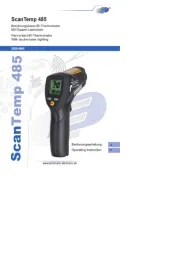
6 September 2025
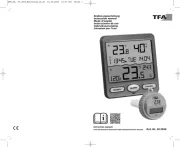
6 September 2025
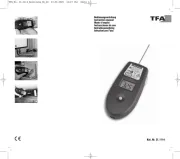
6 September 2025
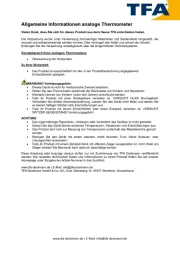
6 September 2025
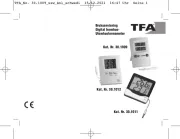
6 September 2025

6 September 2025
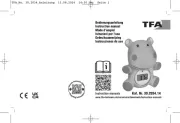
6 September 2025
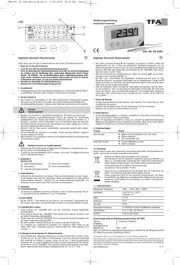
6 September 2025

6 September 2025

6 September 2025
Termometer Manualer
- Neno
- AEG
- Turbotronic
- Vicks
- Reer
- Innovo
- Eurochron
- Telesystem
- Laica
- Grado
- Salter
- PeakTech
- AvaTemp
- Aspen
- Summer
Nyaste Termometer Manualer
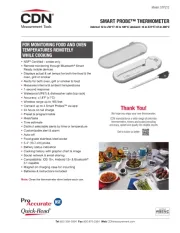
23 Oktober 2025
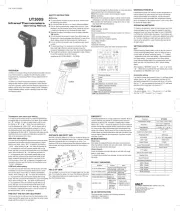
16 Oktober 2025
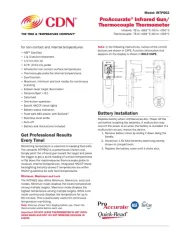
13 Oktober 2025
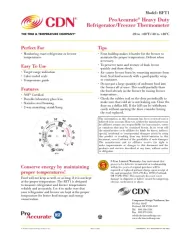
13 Oktober 2025

13 Oktober 2025

13 Oktober 2025
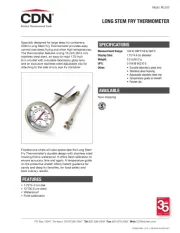
12 Oktober 2025
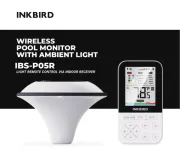
7 Oktober 2025
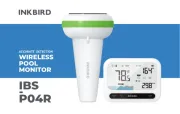
7 Oktober 2025
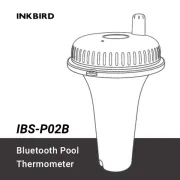
7 Oktober 2025